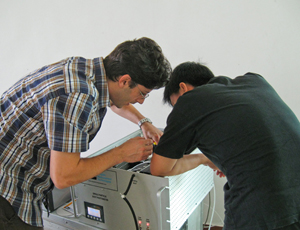2009 News & Events
Researchers Tracking China's Black Carbon
2 February 2009

In the autumn, plumes of air laden with black carbon and other particles sweep southwest out of China's industrial Pearl River Delta. The plumes are formed from diesel combustion, biomass burning, and other activities in Guangzhou and Hong Kong on China's southeast coast. Two scientists from CSD traveled to a research station in rural South China last fall to help scientific colleagues track black carbon and other pollutants downwind of the delta.
"We are particularly interested in black carbon, because it is a very potent warming agent," said CSD's Ru-Shan Gao.
Researchers have long understood that black carbon can damage lungs – that is one of the motivations for the regional Chinese air quality experiment in which Gao and his ESRL colleague, Joshua Schwarz, participated. In recent years, it has also become clear that the particles contribute significantly to atmospheric warming, by absorbing sunlight rather than reflecting it as many other aerosols do.
Gao, Schwarz, and their colleagues are trying to better quantify black carbon abundance and its role in warming. "Climate modelers are interested in using reliable black carbon data to improve model accuracy," Schwarz said.
Our scientists were hosted by Professor Xiaofeng Huang of Peking University, a principal investigator of the multi-site regional air pollution research project known as 3C-STAR. Research sites included the upwind megacity of Guangzhou and the rural Jiangmen research station downwind. In Jiangmen, the scientists and Huang used a Single-Particle Soot Photometer (SP2) to measure the concentration and size distribution of black carbon particles in air.
"The SP2 photometer can be tricky to optimize," Gao said. "To produce good data, it needs a lot of fine tuning." He and Schwarz, an SP2 expert, helped Huang better understand and use the instrument. In return, our CSD researchers will be able to analyze black carbon data from a region unlike any in the United States.
"If I think about our highest measurement in urban Houston, well, this was about four times higher, and we were in a rural area, far downwind of sources," said Schwarz.
The early data look interesting, Schwarz said, and there was at least one completely unexpected event. About 3 a.m., black carbon levels tripled for an hour or so. The spikes likely came from illegal tire burning, done at night, possibly to recycle metals inside the tires.